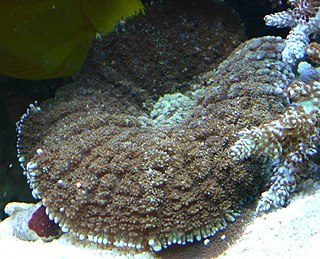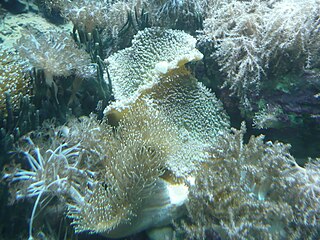
Clownfish or anemonefish are fishes from the subfamily Amphiprioninae in the family Pomacentridae. Thirty species are recognized: one in the genus Premnas, while the remaining are in the genus Amphiprion. In the wild, they all form symbiotic mutualisms with sea anemones. Depending on species, anemonefish are overall yellow, orange, or a reddish or blackish color, and many show white bars or patches. The largest can reach a length of 17 cm, while the smallest barely achieve 7–8 cm.

Anthozoa is a class of marine invertebrates which includes the sea anemones, stony corals and soft corals. Adult anthozoans are almost all attached to the seabed, while their larvae can disperse as part of the plankton. The basic unit of the adult is the polyp; this consists of a cylindrical column topped by a disc with a central mouth surrounded by tentacles. Sea anemones are mostly solitary, but the majority of corals are colonial, being formed by the budding of new polyps from an original, founding individual. Colonies are strengthened by calcium carbonate and other materials and take various massive, plate-like, bushy or leafy forms.

The GloFish is a patented and trademarked brand of genetically engineered fluorescent fish. A variety of different GloFish are currently on the market. Zebrafish were the first GloFish available in pet stores, and are now sold in bright red, green, orange-yellow, blue, pink, and purple fluorescent colors. Recently "Electric Green", "Sunburst Orange", "Moonrise Pink", "Starfire Red", "Cosmic Blue", and "Galactic Purple" colored tetra, an "Electric Green" tiger barb, a glo-Rainbow Shark, and most recently betta have been added to the lineup. Although not originally developed for the ornamental fish trade, it is one of the first genetically modified animals to become publicly available. The rights to GloFish are owned by Spectrum Brands, Inc., which purchased GloFish from Yorktown Technologies, the original developer of GloFish, in May 2017.

A marine aquarium is an aquarium that keeps marine plants and animals in a contained environment. Marine aquaria are further subdivided by hobbyists into fish only (FO), fish only with live rock (FOWLR), and reef aquaria. Fish only tanks often showcase large or aggressive marine fish species and generally rely on mechanical and chemical filtration. FOWLR and reef tanks use live rock, a material composed of coral skeletons harboring beneficial nitrogen waste metabolizing bacteria, as a means of more natural biological filtration.

The Mormyridae, sometimes called "elephantfish", are a family of freshwater fish in the order Osteoglossiformes native to Africa. It is by far the largest family in the order with around 200 species. Members of the family can be popular, if challenging, aquarium species. These fish are also known for having large brain size and unusually high intelligence.

Bubble-tip anemone is a species of sea anemone in the family Actiniidae. Like several anemone species, E. quadricolor can support several anemonefish species, and displays two growth types based on where they live in the water column, one of which gives it the common name, due to the bulbous tips on its tentacles.

Hexacorallia is a class of Anthozoa comprising approximately 4,300 species of aquatic organisms formed of polyps, generally with 6-fold symmetry. It includes all of the stony corals, most of which are colonial and reef-forming, as well as all sea anemones, and zoanthids, arranged within five extant orders. The hexacorallia are distinguished from another class of Anthozoa, Octocorallia, in having six or fewer axes of symmetry in their body structure; the tentacles are simple and unbranched and normally number more than eight. These organisms are formed of individual soft polyps which in some species live in colonies and can secrete a calcite skeleton. As with all Cnidarians, these organisms have a complex life cycle including a motile planktonic phase and a later characteristic sessile phase. Hexacorallia also include the significant extinct order of rugose corals.

Aiptasia is a genus of a symbiotic cnidarian belonging to the class Anthozoa. Aiptasia is a widely distributed genus of temperate and tropical sea anemones of benthic lifestyle typically found living on mangrove roots and hard substrates. These anemones, as well as many other cnidarian species, often contain symbiotic dinoflagellate unicellular algae of the genus Symbiodinium living inside nutritive cells. The symbionts provide food mainly in the form of lipids and sugars produced from photosynthesis to the host while the hosts provides inorganic nutrients and a constant and protective environment to the algae. Species of Aiptasia are relatively weedy anemones able to withstand a relatively wide range of salinities and other water quality conditions. In the case of A. pallida and A. pulchella, their hardiness coupled with their ability to reproduce very quickly and out-compete other species in culture gives these anemones the status of pest from the perspective of coral reef aquarium hobbyists. These very characteristics make them easy to grow in the laboratory and thus they are extensively used as model organisms for scientific study. In this respect, Aiptasia have contributed a significant amount of knowledge regarding cnidarian biology, especially human understanding of cnidarian-algal symbioses, a biological phenomenon crucial to the survival of corals and coral reef ecosystems. The dependence of coral reefs on the health of the symbiosis is dramatically illustrated by the devastating effects experienced by corals due to the loss of algal symbionts in response to environmental stress, a phenomenon known as coral bleaching.

The snakelocks anemone is a sea anemone found in the eastern Atlantic Ocean and the Mediterranean Sea. The latter population is however sometimes considered a separate species, the Mediterranean snakelocks anemone.

Corynactis californica is a brightly colored colonial anthozoan corallimorph. Unlike the Atlantic true sea anemone, Actinia fragacea, that bears the same common name, strawberry anemone, this species is a member of the order Corallimorpharia, and is the only member found in the North American West Coast. Other common names include club-tipped anemone and strawberry corallimorpharian. The anemone can live up to at least 50 meters deep on vertical rock walls, and at the bottom of kelp forests. It is known to carpet the bottom of some areas, like Campbell River in British Columbia, and Monterey Bay in California.

Corallimorpharia is an order of marine cnidarians closely related to stony or reef building corals (Scleractinia). They occur in both temperate and tropical climates, although they are mostly tropical. Temperate forms tend to be very robust, with wide and long columns, whereas tropical forms tend to have very short columns with a wide oral disc and very short tentacles. The tentacles are usually arranged in rows radiating from the mouth. Many species occur together in large groups, although there are recorded instances of individuals. In many respects, they resemble the stony corals, except for the absence of a stony skeleton. Morphological and molecular evidence suggests that they are very closely related to stony corals.

Sea anemones are the marine, predatory animals of the order Actiniaria. They are named after the anemone, a terrestrial flowering plant, because of the colourful appearance of many. Sea anemones are classified in the phylum Cnidaria, class Anthozoa, subclass Hexacorallia. As cnidarians, sea anemones are related to corals, jellyfish, tube-dwelling anemones, and Hydra. Unlike jellyfish, sea anemones do not have a medusa stage in their life cycle.

Condylactis gigantea is a tropical species of ball anemone that is found in shallow reefs and other shallow inshore areas in the Caribbean Sea – more specifically the West Indies – and the western Atlantic Ocean including southern Florida through the Florida Keys. It is also commonly known as: giant Caribbean sea anemone, giant golden anemone, condylactis anemone, Haitian anemone, pink-tipped anemone, purple-tipped anemone, and Florida condy. This species can easily be seen growing in lagoons or in inner reefs as either individuals or loose groups, but never as colonies. They are often used as a model organism along with others in their genus for facultative symbiosis with monocellular algae.

Discosomidae is a family of marine cnidarians closely related to the true sea anemones (Actiniaria). It contains five genera:
Rhodactis howesii is a species of marine cnidarian in the order Corallimorpharia, a sea anemone-like corallimorph found on reefs in tropical regions of the Pacific Ocean. It is commonly known as the green fuzzy mushroom, elephant ear mushroom coral, giant anemone, giant mushroom anemone and giant cup mushroom. This species is toxic when eaten raw and ingestion can cause fatal poisoning.
mCherry is a member of the mFruits family of monomeric red fluorescent proteins (mRFPs). As a RFP, mCherry was derived from DsRed of Discosoma sea anemones unlike green fluorescent proteins (GFPs) which are often derived from Aequoera victoria jellyfish. Fluorescent proteins are used to tag components in the cell, so they can be studied using fluorescence spectroscopy and fluorescence microscopy. mCherry absorbs light between 540-590 nm and emits light in the range of 550-650 nm. mCherry belongs to the group of fluorescent protein chromophores used as instruments to visualize genes and analyze their functions in experiments. Genome editing has been improved greatly through the precise insertion of these fluorescent protein tags into the genetic material of many diverse organisms. Most comparisons between the brightness and photostability of different fluorescent proteins have been made in vitro, removed from biological variables that affect protein performance in cells or organisms. It is hard to perfectly simulate cellular environments in vitro, and the difference in environment could have an effect on the brightness and photostability.

Amplexidiscus fenestrafer, also known as the elephant ear anemone, is a species of coral belonging to the phylum Cnidaria. The name "elephant ear anemone" is a misnomer because it is actually a species of coral. It is the only species in the monotypic genus Amplexidiscus.

Red fluorescent protein (RFP) is a fluorophore that fluoresces red-orange when excited. Several variants have been developed using directed mutagenesis. The original was isolated from Discosoma, and named DsRed. Others are now available that fluoresce orange, red, and far-red.

Ricordea yuma is a species of coral in the family Ricordeidae, order Corallimorpharia; This order of corals do not produce the distinctive calcification of the closely related Scleractinian, or reef building corals. Ricordea yuma are found on the sea floor in relatively shallow, tropical or subtropical ocean environments. Distinctive features include a large mouth disk that takes up most of the organism, and brightly colored tentacles. Ricordea yuma can reproduce both sexually, and asexually by budding a new coral with replicated elements from the mother coral. This may be one mechanism of how they are able to spread and overtake areas rapidly; They have been observed being competitively successful at monopolizing areas by excluding reef-building coral species, after a disturbance in the substrate.


















